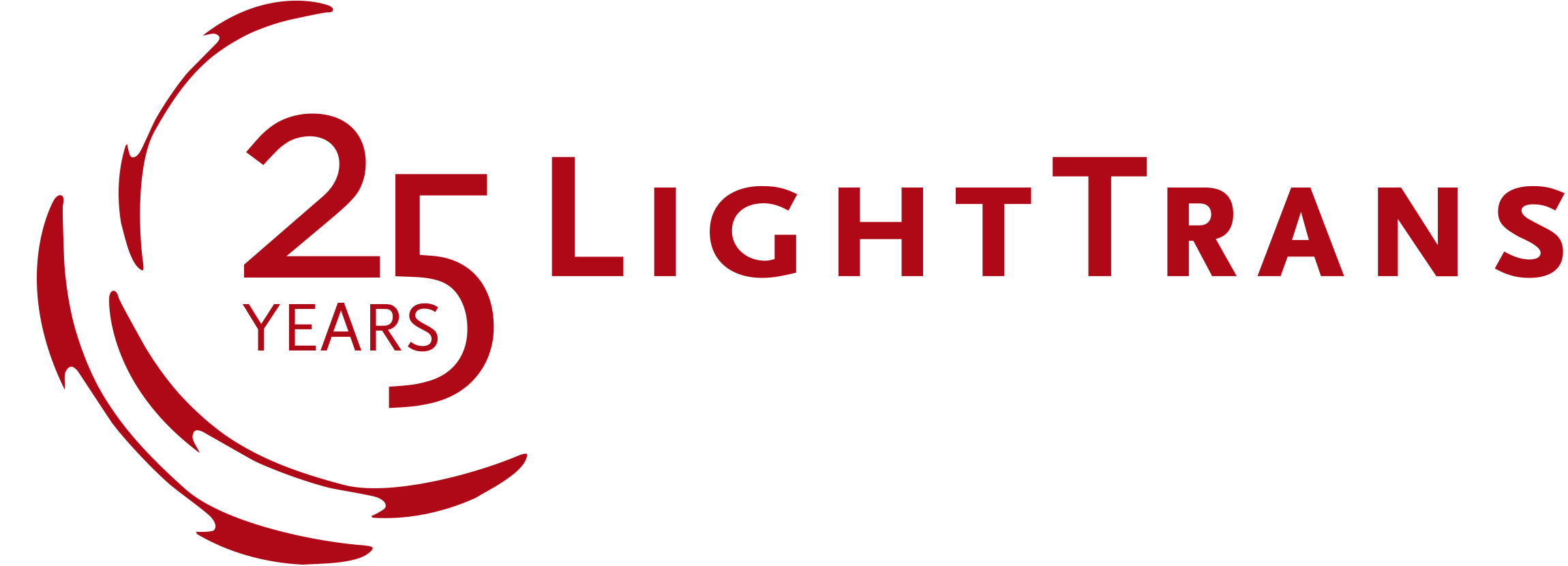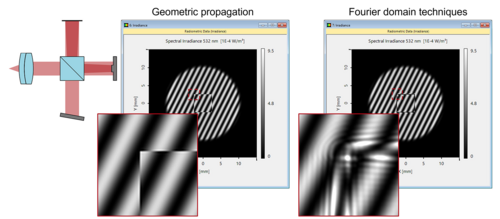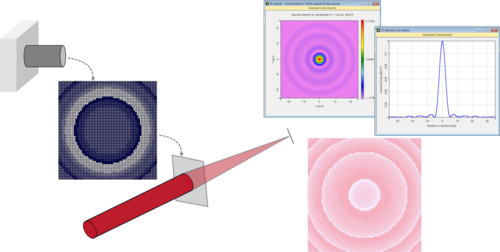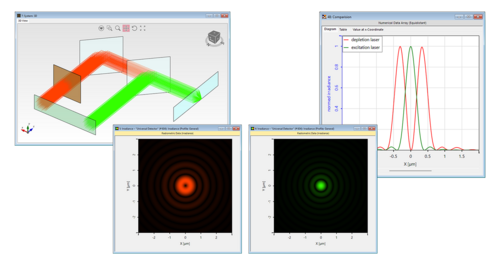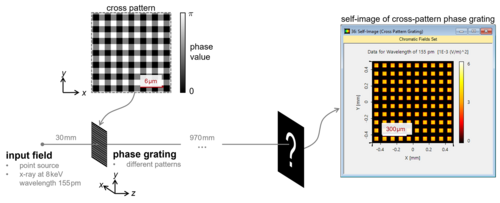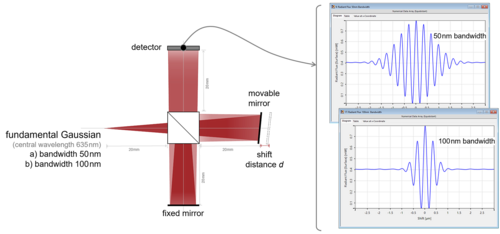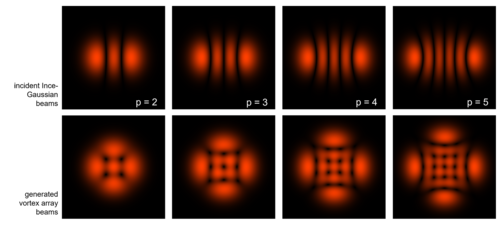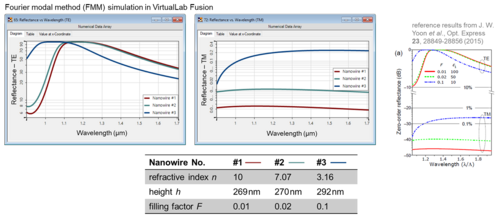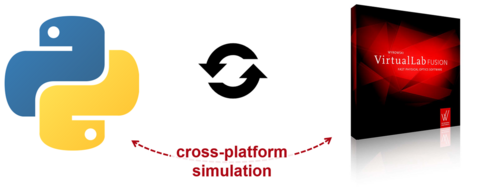What’s new in our Optical Modeling and Design Software?
Diffraction Effects in Interferometry
Optical interferometry – experimental measurement techniques based on the extraction of information from the interaction of light with itself, mostly through the intensity modulation that results from relative phase differences between coherent overlapping fields – is used in many different fields of application, ranging from microscopy to astronomy. While many of those applications can be modeled accurately enough while ignoring diffractive effects, in certain cases, such as when sharp edges or narrow apertures are present in the system, a model capable of taking into account the evolution of diffraction needs to be selected.
VirtualLab Fusion’s flexible pool of interoperable modeling techniques on a single platform helps you achieve the appropriate accuracy-speed balance for your simulation: diffraction effects can be taken into account only when necessary. As a demonstration example, please find below an analysis of a rectangular object sample in an interferometric system. This example includes a comparison of how the result looks depending on whether diffraction is considered or not. Staying with interferometry, we also showcase a demonstration of the working principle of Optical Coherence Tomography (OCT), one of the most important forms of medical imaging.
Read moreOptical Metastructures
Through recent advances in technology, the manufacture of components that use subwavelength structures capable of replicating certain desired emerging properties has become possible for a growing number of applications.
Simulation technology for these so-called metamaterials comes with its own set of challenges, mainly due to the nanoscale structure and high refractive index contrast. The extremely flexible interoperability of modeling techniques offered on a single platform by the optical modeling and design software VirtualLab Fusion allows us, also in this scenario, to adjust the speed-accuracy balance of the simulation to obtain results which are as accurate as needed, as fast as possible.
Take a look at the use cases linked below to find an example showcasing the design of a metalens based on a subwavelength pillar structure.
There is also a deep-dive document explaining the details of our pillar medium, used to model the metalens component in said example.
Stimulated Emission Depletion (STED) Microscopy
Super-resolution microscopes – optical systems that can achieve resolution beyond Abbe’s well-known diffraction limit – have seen a wide array of uses, as obtaining the maximum possible resolution is one of the key objectives in this field. One approach to achieve this is the Stimulated Emission Depletion (STED) concept. Here, a fluorescent specimen is illuminated by two lasers, with one of them shaped by a phase plate into a donut mode. Through chemical processes, the light re-emitted by the sample will stem from the central point of the donut mode only, which can be configured to be much smaller than a classical focal spot, hence increasing the resolution of the image.
The optical modeling and design software VirtualLab Fusion, with its collection of fully interoperable simulation algorithms on a single platform, offers the optical engineer all the necessary tools to fully investigate such systems, including all relevant effects.
In the documents linked below you will find a demonstration of an STED Microscope as well as a detailed look at our Multiple Light Source, a feature of particular importance for this example, since it gives full flexibility to define multiple emitters in a system and to switch each of them on and off independently as desired in order to isolate the different effects which may arise.
Talbot Effect in X-Ray Imaging
X-ray imaging has seen many applications in e.g. the areas of medical imaging and industrial inspection. A common design of X-ray imaging devices is based on the Talbot effect – a diffractive effect, where a periodic structure, like a grating, will produce the exact image of the structure at a certain distance behind it.
Being a software platform based on fast physical optics, VirtualLab Fusion offers suitable solvers to propagate light through such devices, including all diffractive effects. For a short demonstration of VirtualLab Fusion’s capabilities in this area, check out the examples below:
Fourier Transform Spectroscopy
Fourier Transform spectroscopy – an optical metrology method that can be used to measure the optical spectrum of a source with a Michelson interferometer – is a
well-known technique commonly used in a wide range of applications that can go from investigating air or water quality to pharmaceutical analysis.
To help the optical designer understand all the effects that can play a role in such devices, the fast physical optics software VirtualLab Fusion provides all the necessary tools to perform a full propagation through these systems. This naturally includes all coherence and interference effects that are happening at the detector plane. Furthermore, through our new Detector Add-Ons, the user has access to all physical quantities that are of interest, such as irradiance or radiant flux.
Please take a look at the links below to find an example where the temporal coherence length of a polychromatic source is investigated through a Michelson interferometer, as well as some thorough documentation of our Detector Add-Ons.
Ince-Gaussian Beams for Optical Tweezer
Optical tweezers, scientific instruments that utilize highly focused beams to manipulate objects on a sub-microscopic level, can be used to hold individual cells or molecules and have therefore been used for many applications in biology, medicine and nano-chemistry.
To ensure proper functionality of these setups, the beam employed needs to have a stable structure throughout the focusing process. While multiple different fundamental Gaussian, Hermite- or Laguerre-Gaussian modes are good candidates for the task, a setup first proposed by Chu et al. [Opt. Express 16, 19934-19949 (2008)] uses Ince-Gaussian beams, as they are able to create stable 2D-light patterns of increasing complexity.
In the fast physical optics modeling and design software VirtualLab Fusion, the Ince-Gaussian source allows the user to easily configure a custom Ince-Gaussian Mode and use it as a source for their system. Combining this source with a non-sequential modeling approach we demonstrate a full simulation of the system proposed by Chu et al. Please also find below a detailed document describing the functionality and usage of the Ince-Gaussian beam source.
In-Depth Analysis of Polarizer Gratings with Sub-Wavelength Structures
Ultra-sparse nanowire grids – grating structures consisting of periodic dielectric wires with a cross section much smaller than the used wavelength – exhibit strong polarization dependencies over a wide range of wavelengths. These characteristics make them a viable choice as nanostructured polarizers for optical systems, where compact integrability and thermal stability are critical, and this approach has distinct advantages over its conventionally used counterparts based on birefringent crystals or multilayer systems.
In this week’s newsletter we perform a detailed analysis of such a structure in the fast physical optics modeling and design software VirtualLab Fusion, using the work of [J. W. Yoon et al., Opt. Express 23, 28849-28856 (2015)] as a reference. In this example, we not only calculate the polarization-dependent efficiencies of the light reflected and transmitted by the periodic structure, but also visualize how the field propagates inside, clearly illustrating the polarizing behavior of the nanowire arrangement: The TM-polarized part travels through practically unaffected, while the TE-polarized component is almost completely reflected.
This analysis is enabled by VirtualLab Fusion’s Field Inside Component Analyzer: FMM. You can also find a detailed guide to this at the links below.
Cross-Platform Simulations with Python
The fast physical optics software VirtualLab Fusion prides itself on its “connecting field solvers” approach, which brings together different specialized electromagnetic field solvers applied on different components in a seamless, non-sequential way, to enable the physical optics simulation of the whole system. The logical extension of this approach is to not only connect solutions inside the software, but to also allow cross-platform simulations to reap the benefits from other programs or programming languages in combination with the physical-optics know-how that characterizes VirtualLab Fusion, thus extending the options for simulation, optimization, design and post-processing.
Hence, in this week’s newsletter we are doing a deep dive in how to use the programming language Python to call and control simulations in VirtualLab Fusion. Please take a look at the documents linked below to find a detailed guide on how to set up and work with the interface between Python and VirtualLab Fusion, accompanied by an application example in which we perform a parameter sweep on a grating in 1D and 2D.
